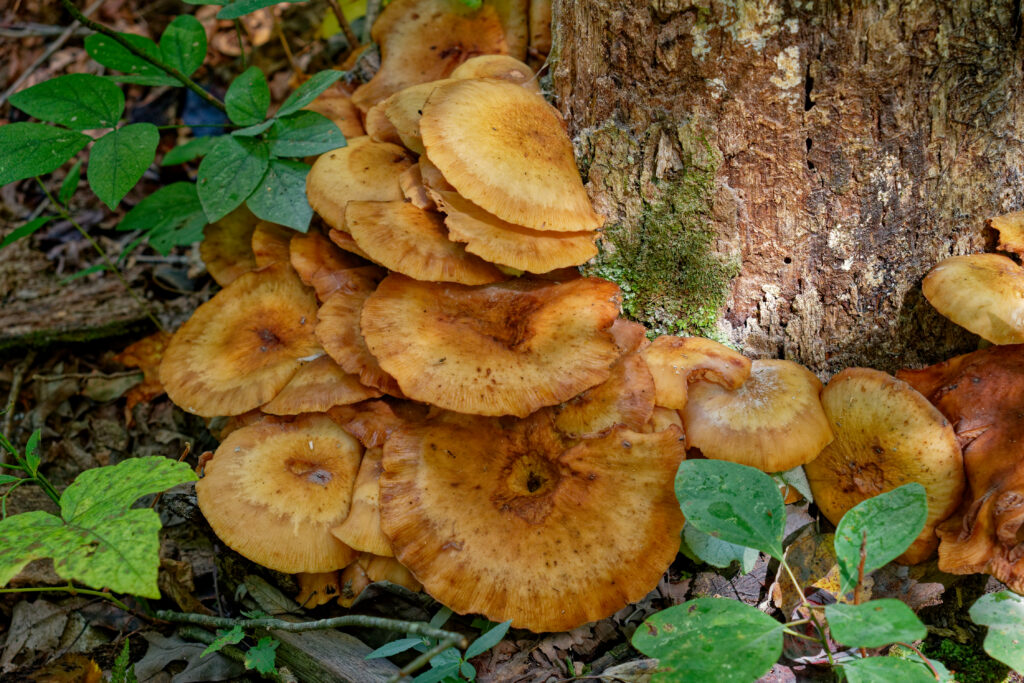
Explore the diverse fungi thriving in Oak Ridge Estates. Learn about local fungal species, their appearances, ecological roles, fruiting times, benefits and drawbacks, and guidelines for safe encounters.
🍄 Fungi
Fungi play critical roles in ecosystems, decomposing organic material, recycling nutrients, and forming symbiotic relationships with plants.
- Golden Chanterelle (Cantharellus californicus): Edible mushroom with golden-yellow, funnel-shaped fruiting bodies. Appears in damp oak forests, typically winter.
- Pros: Highly valued for culinary uses.
- Cons: Risk of overharvesting.
- Death Cap (Amanita phalloides): Highly toxic, greenish cap, white gills. Appears in rainy season, associated with oaks.
- Pros: Important mycorrhizal fungus for tree health.
- Cons: Extremely toxic; potentially fatal if ingested.
- Fly Agaric (Amanita muscaria): Bright red with white spots, toxic and hallucinogenic. Common under pine trees, appears in late fall.
- Pros: Helps nutrient cycling.
- Cons: Toxic if ingested.
- Western Destroying Angel (Amanita ocreata): Deadly toxic, pure white mushroom under oak trees, fruits winter to spring.
- Pros: Mycorrhizal symbiont aiding tree health.
- Cons: Highly poisonous; ingestion can be fatal.
- Jack-o’-Lantern Mushroom (Omphalotus olivascens): Orange, gilled, toxic mushrooms that grow in clusters on wood.
- Pros: Assists in decomposition and nutrient recycling.
- Cons: Causes severe gastrointestinal distress if consumed.
- Turkey Tail (Trametes versicolor): Multi-colored, fan-shaped fungi growing on dead logs and trees. Common year-round, particularly visible in damp seasons.
- Pros: Medicinal properties, assists in wood decomposition.
- Cons: No significant negatives; inedible due to tough texture.
- Oyster Mushroom (Pleurotus ostreatus): Edible, oyster-shaped mushrooms with white to light gray caps, typically growing on hardwoods.
- Pros: Edible and nutritious; aids in decomposition and recycling nutrients.
- Cons: Can resemble other less safe species; accurate identification needed.
🌳 Importance of Oaks to Fungi
Oaks provide essential habitat and nutrients for various fungi species through symbiotic (mycorrhizal) relationships. Oaks supply fungi with sugars produced by photosynthesis, while fungi enhance nutrient and water uptake for the trees. This mutual relationship significantly contributes to ecosystem health, biodiversity, and forest resilience.
🌱 What is Mycorrhizal Fungi?
Mycorrhizal fungi form symbiotic relationships with plant roots, exchanging essential nutrients and enhancing water absorption. Plants provide fungi with sugars, while fungi increase the plant’s access to nutrients and water.
Importance:
- Enhances plant growth and health.
- Improves soil structure and fertility.
- Boosts plant resilience to drought and diseases.
Creating the Perfect Environment:
- Use organic mulches to retain soil moisture.
- Avoid heavy tilling to protect fungal networks.
- Plant native species to encourage natural mycorrhizal relationships.
- Minimize chemical fertilizers and pesticides to prevent damage to fungal communities.
🌿 Importance of Fungi
Fungi are vital to ecosystem function:
- Decompose organic material, enhancing soil fertility.
- Form mutualistic relationships with plants (mycorrhiza), boosting plant growth.
- Contribute to nutrient cycling and ecological balance.
- Serve as indicators of environmental health.
🚨 Fungi Safety Guidelines
- Do not consume wild mushrooms without expert identification.
- Contact local mycology groups or professionals for identification assistance.
- If you suspect poisoning, immediately contact poison control at 1-800-222-1222.
- Keep children and pets away from unfamiliar fungi.
- Avoid handling toxic fungi without protective gloves.
🌎 Conclusion
Understanding and respecting fungi enhances our appreciation of local ecosystems and promotes community safety. By recognizing the importance and unique characteristics of fungi, residents of Oak Ridge Estates can actively support biodiversity and environmental health. Together, we can maintain the ecological balance and natural beauty of our Oak Ridge Estates community.